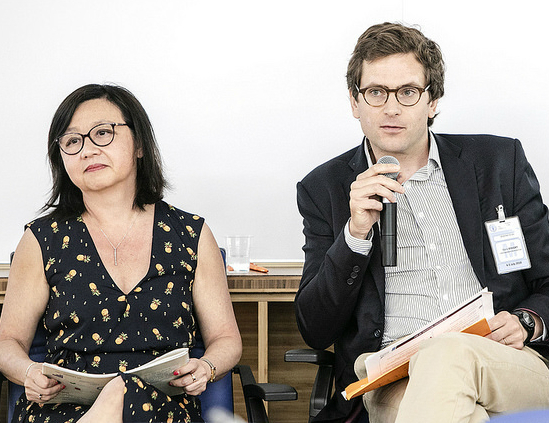Private investors transforming development finance landscape

Impact investing has been gaining steam in recent years, as private investors keen to make a difference are increasingly putting their money behind initiatives that generate social and environmental impacts alongside financial returns.
According to a survey by the Global Impact Investing Network, the world’s leading impact investors currently manage a total of USD 228 billion in impact assets – double what it was a year ago.
That’s more than the amount of public funding that was available through official development assistance in 2017, and yet “it’s just a drop in the ocean when you consider the trillions of dollars in total private investment available across the globe,” said Emmanuel Hidier, an FAO senior economist.
 Delivering on the Sustainable Development Goals (SDGs) by 2030 requires a massive influx of funding, especially from the private sector. And impact investors are set to play an important role especially if this upward trend continues.
Delivering on the Sustainable Development Goals (SDGs) by 2030 requires a massive influx of funding, especially from the private sector. And impact investors are set to play an important role especially if this upward trend continues.
“What’s interesting is that impact investing is bridging two worlds that really weren’t talking with one other – the private investment world and the more traditional development finance world. And many impact investors are turning their attention to food and agriculture,” Hidier added.
Greener planet
During FAO’s Investment Days 2018 – a unique event that brings together investment specialists from the public and private sectors – panellists shared their experiences of balancing the bottom line with positive social and environmental impacts.
The Land Degradation Neutrality Fund, for example, blends public, private and philanthropic resources for sustainable land management and land restoration projects with the ultimate goal of a land degradation-neutral world by 2030.
The Fund, whose anchor investors are the European Investment Bank and the French Development Agency, was launched at the UN Convention to Combat Desertification’s COP 13 in China last year, said Boris Spassky, the Fund’s Investment Director.
“We provide long-term patient capital that will restore green cover to the planet, capture more carbon and generate profits. It’s risky, as banks generally don’t lend for primary production. But our role is to be catalytic and attract private investors who wouldn’t dare enter on their own,” he said.
Efficient supply chains
Producing enough food to feed a growing global population while also preserving natural resources is a daunting challenge, especially amid a changing climate.
The Livelihoods Funds, backed by private companies, seek to find practical and efficient solutions to those challenges – and build more resilient communities, ecosystems and sustainable businesses.
Its Livelihoods Fund for Family Farming aims to transform supply chains to the benefit of all by investing in large-scale projects to help small-scale farmers produce more and of higher quality while preserving their natural resources. Its investors then agree to buy these commodities from the Fund’s projects for up to ten years.
“Whether it’s milk in Kenya or vanilla in Madagascar with smallholders, the long-term commitment of our investors is the key to deeply transforming these supply chains,” said Bernard Giraud, President and Cofounder of Livelihoods Venture.
“Livelihoods Funds will invest over USD 240 million. The challenge is to design projects that are successful for both farmers and businesses. It’s not one against the other, but about enlarging the pie,” he said.
Its other fund, the Livelihoods Carbon Fund, uses the carbon economy to finance ecosystem restoration, agroforestry and rural energy projects.
Taking cue from the SDGS
Another institution, PAMIGA – the Participatory Microfinance Group for Africa – promotes better access to innovative financial and technical services in rural sub-Saharan Africa, especially on renewable energy and water. Its microfinance institutions reach more than one million clients, with a savings portfolio of 55 million euros and a loan portfolio of 85 million euros.
Renée Chao-Béroff, PAMIGA’s general manager, underscored the importance of an integrated approach for achieving impact, saying that access to finance must go hand-in-hand with technical assistance to help investees reach their objectives.
The investment and advisory firm ThirdWay Africa hopes to “become like the anchor tenant in a shopping mall, drawing other investors into rural communities,” said its CEO Gonçalo Neves-Correia. The firm will soon launch an impact investment private equity vehicle focused on agriculture and other rural real assets in Indian Ocean Africa, with investments ranging from USD 10 to USD 15 million.
“We think this is attractive for investors; demographically, Africa has an ever-increasing market for agricultural output; and on the supply side, we have technology-enabled solutions we didn’t have in the past,” he said.

Taking its cue from the SDGs, the Fund aims for measurable impacts on education, livelihoods, wellness and climate-smart development.
Alternative financing
Another financing source with excellent potential is crowdfunding. MiiMOSA is the first ever crowdfunding platform dedicated exclusively to food and agriculture.
Florian Breton, President of MiiMOSA, said that in just three years they were able to raise 7 million euros and now count around 90,000 members. Citizens – increasingly interested in the food they eat, how it’s grown or prepared, whether it’s local or seasonal – are helping to shape the future of food and agriculture by investing in these initiatives.
Opportunities
Organizations like FAO can help impact investors, Hidier said, especially as they have to report on social and environmental impact in addition to the financial bottom line.
“We can offer a package of services to these investors, whether it’s helping them define the types of impact they want to target and then identifying good, clear indicators, or improving impact monitoring by using digital technologies to assess land degradation and water use,” he added. “This is a new area for us, but the opportunities are there.”
Cover image: Sapa, Vietnam © Jordi VaquéPhoto 1: Gonçalo Neves-Correia, Bernard Giraud and Florian Breton at FAO Investment Days 2018 © FAO/Giuseppe CarotenutoPhoto 2: Renée Chao-Béroff and Boris Spassky at FAO Investment Days 2018 © FAO/Giuseppe Carotenuto
